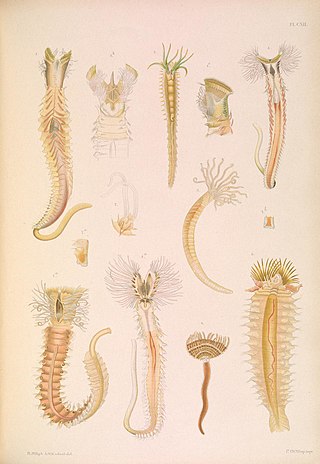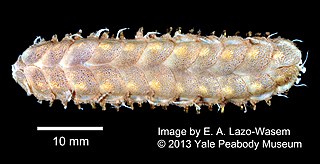
Nereis is a genus of polychaete worms in the family Nereididae. It comprises many species, most of which are marine. Nereis possess setae and parapodia for locomotion and gas exchange. They may have two types of setae, which are found on the parapodia. Acicular setae provide support. Locomotor setae are for crawling, and are the bristles that are visible on the exterior of the Polychaeta. They are cylindrical in shape, found not only in sandy areas, and they are adapted to burrow. They often cling to seagrass (posidonia) or other grass on rocks and sometimes gather in large groups.
The following is a list of players and managers (*), both past and current, who appeared at least in one regular season game for the Chicago White Sox franchise.

Eunicidae is a family of marine polychaetes. The family comprises marine annelids distributed in diverse benthic habitats across Oceania, Europe, South America, North America, Asia and Africa. The Eunicid anatomy typically consists of a pair of appendages near the mouth (mandibles) and complex sets of muscular structures on the head (maxillae) in an eversible pharynx. One of the most conspicuous of the eunicids is the giant, dark-purple, iridescent "Bobbit worm", a bristle worm found at low tide under boulders on southern Australian shores. Its robust, muscular body can be as long as 2 m. Eunicidae jaws are known from as far back as Ordovician sediments. Cultural tradition surrounds Palola worm reproductive cycles in the South Pacific Islands. Eunicidae are economically valuable as bait in both recreational and commercial fishing. Commercial bait-farming of Eunicidae can have adverse ecological impacts. Bait-farming can deplete worm and associated fauna population numbers, damage local intertidal environments and introduce alien species to local aquatic ecosystems.

Harmothoe is a genus of marine Polychaete worms belonging to the family Polynoidae. Species of Harmothoe are found world-wide to depths of at least 5,000 m but are more common in shallower water.

Eunice is a genus in the polychaete family Eunicidae. Individuals grow to a length of between 0.5 and 300 cm. Their bodies have multiple segments. They have two eyes and five tentacles. They have well-developed sense organs and relatively large brains. Their color is dark purple-brown to red-brown with a white ring at the fourth segment. They are found in oceans and seas around the world. They have an evertible proboscis with distinctive mouthparts, some of which comprise two rows of maxilliary plates in a radula-like fashion.

Ampharete is a genus of polychaete annelid worms. They have a single, chevron-shaped row of teeth.

Dodecaceria is a genus of marine polychaete worms in the family Cirratulidae. It's also one of the very few polychaete genera with a verified fossil record.
Salmacina is a genus of marine polychaete worms in the family Serpulidae. The type taxon is Salmacina incrustans Claparède, 1870.

Syllidae, commonly known as the necklace worms, is a family of small to medium-sized polychaete worms. Syllids are distinguished from other polychaetes by the presence of a muscular region of the anterior digestive tract known as the proventricle.

Lepidasthenia is a genus of marine Polychaete worms belonging to the family Polynoidae. Species of Lepidasthenia are found worldwide to depths of about 1200 m but are more common in shallower water.

Bispira is a genus of marine bristleworm in the family Sabellidae. Its members were initially included in genus Sabella by Grube in 1851. In 1856, Krøyer described Bispira as a separate genus. Members of Bispira are defined by spirally-coiled, equally-divided branchial lobes.

Acromegalomma interruptum is a bristle worm from the Sabellidae family. The body of the worm consists of a head, a cylindrical, segmented body and a tailpiece. The head consists of a prostomium and a peristomium and carries paired appendages.

Lepidonotus is a genus of marine annelids in the family Polynoidae. The genus occurs globally and includes 80 species, usually found in shallow waters down to about 80 metres.

Odontosyllis is a genus of annelids belonging to the family Syllidae.
Chone is a genus of polychaetes belonging to the family Sabellidae.

Flabelligera is a genus of polychaetes in the family Flabelligeridae. Species are common around the world, in both temperate and cold waters. Flabelligera species have long, club-like papillae, which are encased in a smooth mucus sheath. They also have a distinct cephalic cage, and hooked neurochaeatae which they use to hold onto rocks.












